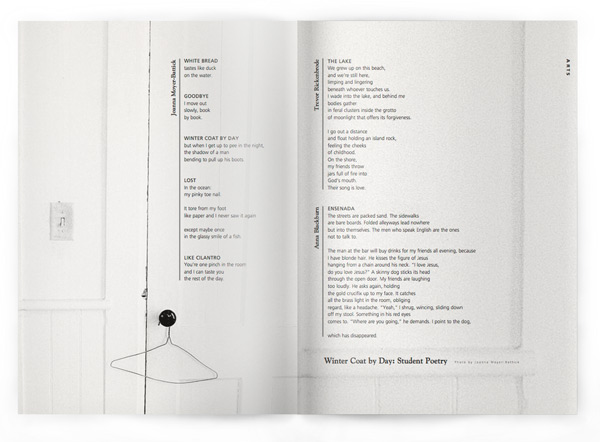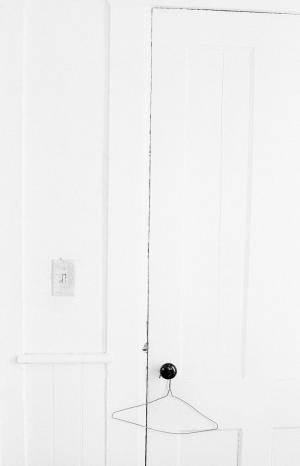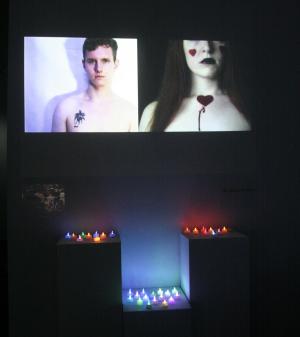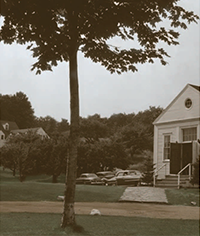
Joanna Moyer-Battick
 White Bread
White Bread
tastes like duck
on the water.
Goodbye
I move out
slowly, book
by book.
Winter Coat by Day
but when I get up to pee in the night,
the shadow of a man
bending to pull up his boots.
Lost
In the ocean:
my pinky toe nail.
It tore from my foot
like paper and I never saw it again
except maybe once
in the glassy smile of a fish.
Like Cilantro
You’re one pinch in the room
and I can taste you
the rest of the day.
Trevor Rickenbrode
The Lake
We grew up on this beach,
and we’re still here,
limping and lingering
beneath whoever touches us.
I wade into the lake, and behind me
bodies gather
in feral clusters inside the grotto
of moonlight that offers its forgiveness.
I go out a distance
and float holding an island rock,
feeling the cheeks
of childhood.
On the shore,
my friends throw
jars full of fire into
God’s mouth.
Their song is love.
Anna Blackburn
Ensenada
The streets are packed sand. The sidewalks
are bare boards. Folded alleyways lead nowhere
but into themselves. The men who speak English are the ones
not to talk to.
The man at the bar will buy drinks for my friends all evening, because
I have blonde hair. He kisses the figure of Jesus
hanging from a chain around his neck. “I love Jesus,
do you love Jesus?” A skinny dog sticks its head
through the open door. My friends are laughing
too loudly. He asks again, holding
the gold crucifix up to my face. It catches
all the brass light in the room, obliging
regard, like a headache. “Yeah,” I shrug, wincing, sliding down
off my stool. Something in his red eyes
comes to. “Where are you going,” he demands. I point to the dog,
which has disappeared.
Reflections: Seniors Exhibit Their Work
 Annie Malamet studied empowerment through the paintings of Sofonisba Anguissola, the Italian Renaissance artist, and prepared an exhibit of video art using martyr iconography to investigate themes of self-possession. “I use medieval and Renaissance martyr imagery to discuss issues of sexual violence and its place in the larger context of fine art as well as pop culture,” said Annie. “Borrowing iconography from paintings of Christian martyrs, I have re-created these images in the form of live-action vignettes.”
Annie Malamet studied empowerment through the paintings of Sofonisba Anguissola, the Italian Renaissance artist, and prepared an exhibit of video art using martyr iconography to investigate themes of self-possession. “I use medieval and Renaissance martyr imagery to discuss issues of sexual violence and its place in the larger context of fine art as well as pop culture,” said Annie. “Borrowing iconography from paintings of Christian martyrs, I have re-created these images in the form of live-action vignettes.”
Willie Finkel received a degree in American studies, with a focus on curatorial studies and ceramics. He complemented his study of the Civil War with an exhibit featuring art from Marlboro ceramics professors and students over the years, including his own, shown here. Willie said, “I believe that our relationship to happiness, joy and beauty can accentuate our understanding of the past just as much as tragedy and sadness. So I tried to harness one of those qualities, our sense of beauty, to connect people to the past.”
Zach Parks used visual arts and philosophy to investigate the links between machines, technology and art. “In my work, I aim to explore relationships, actions and attitudes both human and mechanical,” said Zach. “A machine is a collection of parts working together to perform some sort of action, but may also be considered a series of abstract functions, or a group of mechanical relationships from which the final action emerges.” This piece, called “Cranes,” was one of several in Zach’s Drury Gallery exhibition.
 Nick Rouke, who received a degree in visual arts, explored concepts of time, loss and absence through photographic work, including a series of portraits of his fellow students. “Once I started to understand how I felt and accepted that I wouldn’t ever be able to answer some questions, I started making work that was more a reflection of my perspective rather than dramatic statements that are trying too hard to be profound declarations of truth,” said Nick.
Nick Rouke, who received a degree in visual arts, explored concepts of time, loss and absence through photographic work, including a series of portraits of his fellow students. “Once I started to understand how I felt and accepted that I wouldn’t ever be able to answer some questions, I started making work that was more a reflection of my perspective rather than dramatic statements that are trying too hard to be profound declarations of truth,” said Nick.

